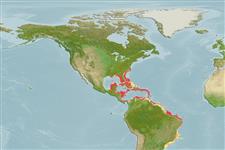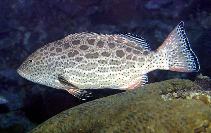Mycteroperca venenosa (Linnaeus, 1758)
Yellowfin grouper
Add your observation in Fish Watcher
| Native range | All suitable habitat | Point map | Year 2050 |

|
| This map was computer-generated and has not yet been reviewed. |
| Mycteroperca venenosa AquaMaps Data sources: GBIF OBIS |
Upload your photos and videos
Pictures | Videos | Sounds | Stamps, coins, misc. | Google imageMycteroperca venenosa
Picture by Patzner, R.
Pictures | Videos | Sounds | Stamps, coins, misc. | Google imageMycteroperca venenosa
Picture by Patzner, R.
United States (contiguous states) country information
Common names:
Aguaji, Bonaci arara, Grouper
Occurrence: native
Salinity: brackish
Abundance: | Ref:
Importance: | Ref:
Aquaculture: | Ref:
Regulations: | Ref:
Uses: gamefish: yes;
Comments: Also Ref. 276, 26280, 115025.
National Checklist:
Country Information: https://www.cia.gov/library/publications/resources/the-world-factbook/geos/us.html
National Fisheries Authority: http://www.nmfs.gov
Occurrences: Occurrences Point map
Main Ref: Heemstra, P.C. and J.E. Randall, 1993
National Database:
Occurrence: native
Salinity: brackish
Abundance: | Ref:
Importance: | Ref:
Aquaculture: | Ref:
Regulations: | Ref:
Uses: gamefish: yes;
Comments: Also Ref. 276, 26280, 115025.
National Checklist:
Country Information: https://www.cia.gov/library/publications/resources/the-world-factbook/geos/us.html
National Fisheries Authority: http://www.nmfs.gov
Occurrences: Occurrences Point map
Main Ref: Heemstra, P.C. and J.E. Randall, 1993
National Database:
Common names from other countries
Classification / Names Κοινά ονόματα | Συνώνυμα | Catalog of Fishes(Γένος, Είδη) | ITIS | CoL | WoRMS | Cloffa
> Perciformes/Serranoidei (Groupers) > Epinephelidae (Groupers)
Etymology: Mycteroperca: Greek, mykter, -eros = nose + Greek, perke = perch (Ref. 45335).
More on author: Linnaeus.
Etymology: Mycteroperca: Greek, mykter, -eros = nose + Greek, perke = perch (Ref. 45335).
More on author: Linnaeus.
Environment: milieu / climate zone / depth range / distribution range Οικολογία
Θαλασσινό(ά) Υφαλόφιλο(α); εύρος βάθους 2 - 137 m (Ref. 5222), usually 5 - 35 m (Ref. 40849). Subtropical; 35°N - 28°S, 92°W - 33°W (Ref. 5222)
Κατανομή Χώρες | Περιοχές FAO | Οικοσυστήματα | Παρουσίες | Point map | Εισαγωγές | Faunafri
Western Atlantic: Bermuda, Gulf of Mexico and the Caribbean south to Sao Paulo, Brazil.
Length at first maturity / Μέγεθος / Βάρος / Age
Maturity: Lm 53.6, range 50 - 63 cm
Max length : 100.0 cm TL αρσενικό/απροσδιόριστο; (Ref. 26340); common length : 50.0 cm TL αρσενικό/απροσδιόριστο; (Ref. 5217); μεγ. δημοσιευμένο βάρος: 18.5 kg (Ref. 40637)
Max length : 100.0 cm TL αρσενικό/απροσδιόριστο; (Ref. 26340); common length : 50.0 cm TL αρσενικό/απροσδιόριστο; (Ref. 5217); μεγ. δημοσιευμένο βάρος: 18.5 kg (Ref. 40637)
Short description Κλείδες προσδιορισμού | Μορφολογία | Μορφομετρία
Ραχιαίες άκανθες (συνολικά) : 11; Μαλακές ραχιαίες ακτίνες (συνολικά) : 15 - 16; Εδρικές άκανθες: 3; Μαλακές εδρικές ακτίνες: 10 - 12. Distinguished by the following characteristics: Head and body have oval groups of dark spots; outer third of pectoral fin bright yellow (Ref. 26938); two color morphs: a deep-water reddish form and shallow-water greenish form; depth of body contained 2.9-3.2 times in SL; head length 2.6-2.9 times in SL; convex interorbital area; evenly rounded preopercle or with slight notch, without projecting bony lobe at the angle; nostrils subequal or posterior nostrils with diameter twice the size of anterior nostrils (Ref. 89707).
Adults found on rocky and coral reefs, juveniles occur in shallow turtle grass beds. Also been taken in trawls over mud bottom in the northern Gulf of Mexico. Feeds mainly on fishes (mostly on coral reef species) and squids. Although often implicated in ciguatera poisonings, it is a desirable food fish; and even large (5 to 10 kg) fish from areas considered safe are sold in markets. Also caught with surface trolling. Sex-reversal has been observed (Ref. 5521).
Life cycle and mating behavior Γεννητική Ωρίμανση | Αναπαραγωγή | Γεννοβολία | Αβγά | Γονιμότητα | Προνύμφες
Main reference
Upload your references | Αναφορές | Συντονιστής | Συνεργάτες
Heemstra, P.C. and J.E. Randall, 1993. FAO Species Catalogue. Vol. 16. Groupers of the world (family Serranidae, subfamily Epinephelinae). An annotated and illustrated catalogue of the grouper, rockcod, hind, coral grouper and lyretail species known to date. Rome: FAO. FAO Fish. Synop. 125(16):382 p. (Ref. 5222)
IUCN Red List Status (Ref. 130435: Version 2024-2)
Near Threatened (NT) (A4bd); Date assessed: 12 March 2018
Human uses
αλιεία: πολύ εμπορικό; αλιεία αναψυχής: ναί; Ενυδρείο: Δημόσια ενυδρεία
FAO(αλιεία: Παραγωγή; publication : search) | FishSource | Η θάλασσα γύρω μας
Περισσότερες πληροφορίες
Population dynamics
Παράμετροι Αύξησης
Max. ages / sizes
Length-weight rel.
Length-length rel.
Length-frequencies
Mass conversion
Στρατολόγηση
Αφθονία
Παράμετροι Αύξησης
Max. ages / sizes
Length-weight rel.
Length-length rel.
Length-frequencies
Mass conversion
Στρατολόγηση
Αφθονία
Life cycle
Αναπαραγωγή
Γεννητική Ωρίμανση
Γονιμότητα
Γεννοβολία
Spawning aggregations
Αβγά
Egg development
Προνύμφες
Δυναμική προνυμφών
Αναπαραγωγή
Γεννητική Ωρίμανση
Γονιμότητα
Γεννοβολία
Spawning aggregations
Αβγά
Egg development
Προνύμφες
Δυναμική προνυμφών
Anatomy
Επιφάνεια βραγχίων
Brain
Otolith
Επιφάνεια βραγχίων
Brain
Otolith
Physiology
Body composition
Nutrients
Κατανάλωση οξυγόνου
Κολυμβητικός τύπος
Ταχύτητα κολύμβησης
Visual pigments
Fish sound
Diseases & Parasites
Toxicity (LC50s)
Body composition
Nutrients
Κατανάλωση οξυγόνου
Κολυμβητικός τύπος
Ταχύτητα κολύμβησης
Visual pigments
Fish sound
Diseases & Parasites
Toxicity (LC50s)
Genetics
Γενετική
Heterozygosity
Κληρονομικότητα
Γενετική
Heterozygosity
Κληρονομικότητα
Human related
Aquaculture systems
Προφίλ υδατοκαλλιεργειών
Στελέχοι
Ciguatera cases
Stamps, coins, misc.
Aquaculture systems
Προφίλ υδατοκαλλιεργειών
Στελέχοι
Ciguatera cases
Stamps, coins, misc.
Εργαλεία
Bio-Quiz | E-book | Οδηγός πεδίου | Κλείδες προσδιορισμού | Ανάλυση κατά μήκος συνθέσεων | Εργαλείο ιστορίας ζωής | Σημειακός χάρτης | Classification Tree
| Catch-MSY |
Special reports
Download XML
Διαδικτυακές πηγές
Aquatic Commons | BHL | Cloffa | Websites from users | Check FishWatcher | CISTI | Catalog of Fishes(Γένος, Είδη) | DiscoverLife | ECOTOX | Faunafri | Fishtrace | GenBank(genome, nucleotide) | GloBI | GOBASE | | Google Books | Google Scholar | Google | IGFA World Record | MitoFish | Εθνικές βάσεις δεδομένων | Otolith Atlas of Taiwan Fishes | PubMed | Reef Life Survey | Scirus | SeaLifeBase | Δέντρο Ζωής | Wikipedia(Go, αναζήτηση) | World Records Freshwater Fishing | Zoological Record
Estimates based on models
Preferred temperature (Ref. 115969): 24.3 - 28, mean 27 (based on 310 cells).
Phylogenetic diversity index (Ref. 82804): PD50 = 0.5000 [Uniqueness, from 0.5 = low to 2.0 = high].
Bayesian length-weight: a=0.01122 (0.00715 - 0.01760), b=3.04 (2.91 - 3.17), in cm Total Length, based on LWR estimates for this species & Genus-body shape (Ref. 93245).
Τροφικό Επίπεδο (Ref. 69278): 4.5 ±0.5 se; based on diet studies.
Ελαστικότητα (Ref. 120179): Χαμηλό, ελάχιστος χρόνος για διπλασιασμό πληθυσμού 4,5 - 14 έτη (K=0.09-0.17; tmax=15; Fec=400,000).
Fishing Vulnerability (Ref. 59153): High vulnerability (62 of 100).
Climate Vulnerability (Ref. 125649): Very high vulnerability (86 of 100).




